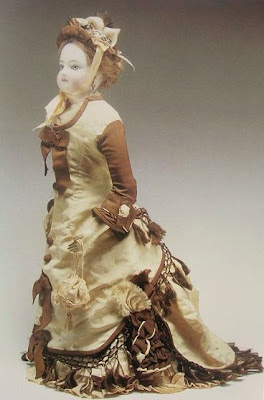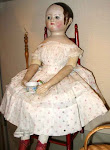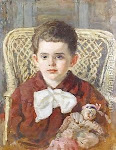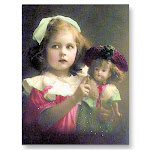
THE HISTORY OF the Fashion dolls was at first closely bound up with that of France. It confirms the natural pre-eminence of Paris in the world of fashion to find an English Queen sending over for the latest French styles as early as the fourteenth century, presumably unsatisfied by the products of her native country.
 Louis XIV wanted all of Europe to know about Paris fashions so he began sending life-sized fashion dolls to every European Court. The dolls were dressed in the latest styles. Noble ladies would have their tailors imitate the clothes, footwear, hats and accessories on the latest dolls.
Louis XIV wanted all of Europe to know about Paris fashions so he began sending life-sized fashion dolls to every European Court. The dolls were dressed in the latest styles. Noble ladies would have their tailors imitate the clothes, footwear, hats and accessories on the latest dolls.
The miniature fashion dolls were passed from court to court throughout Europe. They were exquisite and represented the latest word in fashion and trimmings. These alabaster or china dolls were sent to Europe and America in the 19th century.. From all this we can conclude that early Fashion dolls were on a larger scale and more richly dressed than the ordinary play-dolls of the same period.
 E. Barrois, France...One of the earliest French doll factories was owned by Mme Barrois and was based in the Rue St. Martin, Paris. This is a fine example of her work.
E. Barrois, France...One of the earliest French doll factories was owned by Mme Barrois and was based in the Rue St. Martin, Paris. This is a fine example of her work. Francois Gaultier ca. 1875...featuring "polonaise" walking dress
Francois Gaultier ca. 1875...featuring "polonaise" walking dressof spotted grosgrain silk in ivory with brown sleeves trimmed with tassels and bows. Beautiful head of bisque with fixed eyes of grey glass.
********************
During the eighteenth century, when European travel became freer, and numerous small continental courts sprang up and flourished, the demands upon the wardrobes of their great ladies, was of the outmost.
**************************
And it was always with England that the main French fashion trade was exchanged even, when the hostilities between the two countries might have been expected to hinder such frivolous interchanges, an act of gallantry which is worthy of being noted in the chronicles of history for the benefit of the ladies, the ministers of both courts granted a special pass to the mannequin.
 Jumeau, ca. 1880
Jumeau, ca. 1880Bisque head with articulated neck, fixed eyes of blue glass, closed mouth and pierced ears.
 Exquisite French cabinet size doll with trunk and accesories, including:
Exquisite French cabinet size doll with trunk and accesories, including:Toiletries and under-things, hat boxes, stationary and miniatures wall hangings.
Gorgeous Bru face with clear blue glass eyes.
**********************
'That pass was always respected, and during the times of greatest enmity experienced on both sides the mannequin was the one object which remained unmolested'
*******************
Manikin doll with wardrobe-France, 1865-70
 Articulated pale bisque shoulder head on articulated wooden body..possibly Bru.
Articulated pale bisque shoulder head on articulated wooden body..possibly Bru.elaborate wardrobe consisting of walking and day dresses. Embroidered on her nightdress are the initials "M.C." The doll originally belonged to the House of Savoy.

Manikin doll wearing a summer walking dress in pink and white stripe. Bisque shoulder head with blue glass eyes, body made of kid and fully gusseted for movement.

E. B. for Eugene Barrois, blue glass eyes, pierced ears, beautifully painted full lips, and her original strawberry blonde mohair wig.On a fully articulated twill over wood body which allows her to assume a multitude of positions, it is fitted with lovely bisque arms. Beautifully costumed in pale gold satin, accented by fine lace, shimmering pearls and luxurious bows. Orange blossoms in her hair add yet another dimension. )

 The most facinating thing about a doll is its face, and no amount of technical ingenuity in the construction of the body, or sumptuous clothes can make up for a face that lacks charm.
The most facinating thing about a doll is its face, and no amount of technical ingenuity in the construction of the body, or sumptuous clothes can make up for a face that lacks charm. 18th century fashion required a lot of work. Some went to such lengths that the following rather panicky law was proposed in 1770 (but thankfully never passed):
18th century fashion required a lot of work. Some went to such lengths that the following rather panicky law was proposed in 1770 (but thankfully never passed):
An Act to protect men from being beguiled into marriage by false adornments.
All women, of whatever rank, age, profession or degree, whether virgins, maids or widows, that shall, from and after such Act, impose upon, seduce or betray into matrimony, any of His Majesty's subjects, by the scents, paints, cosmetic washes, artificial teeth, false hair, Spanish wool, iron stays, hoops,high-heeled shoes and bolstered hips, shall incur the penalty of the law in force against witchcraft and like misdemeanours and that the marriage upon conviction shall stand null and void.
********************
'Macaronis'

This law makes it sound as though only ladies were vain, but men were just as careful about their appearance as women, and in some cases more so. Fashionistos called Macaronis were infamous for their eccentric styles, often wearing make-up as the ladies did, and earrings. They traveled in groups; were extremely egocentric, and basically annoyed everyone else with their flamboyant presence.

An Annapolis-based specialty auction house has brokered the world record sale of an antique doll with the auctioning of a circa 1914 French art doll sculpted by Albert Marque.

"In every collecting category there is that one piece, that one thing that every great collector dreams of owning," said Stuart Holbrook, president of Theriault's, the local firm specializing in the trade of antique childhood items.
"For doll collectors, the Marque is the pinnacle. It has the allure, the value and the beauty that is very compelling. It's one of the most incredible creations ever made."Holbrook said there are only 20 to 30 known Marque dolls still in existence, many of them in museums".

The name comes from the Macaroni Club, founded in 1760 by a group of young men who had made the Grand Tour of Europe, of which Italy was the high spot and thus favored anything that was ‘exotic’, including the rare Italian cuisine. They loved to gamble, gossip and wasted countless pounds of frivolous things.
*****************
Ethereal Promoters of Fashions
 "Broken Doll"
"Broken Doll"Until the early years of the twentieth century, children's clothes were still influenced by those of adults. They were replicas in miniature. Girls were brought up to model themselves on the adults around them, so they joys of infancy and childhood were denied almost entirely in the rush to grow up and join the social rituals of middle-class life.

"Automaton Group of French Dolls" Jumeau, Roullet Decamps and Maison Steiner.

Fashion dolls while expensive were very popular among the affluent Victorians and each was carefully selected by the mother. Every item necessary for the fashionable lady of the 19th century toilette was duplicated in miniature for these dolls. In Paris there where whole shops that sold nothing but items for these lovely ladies which included everything from gloves, furniture, stationery, wigs, shoes, dresses to silk parasols. It could be said that these dolls were as pampered then as they are prized today.
 The demise of the French Fashion resulted from the rising popularity of the French Bisque child doll which were made to represent children. These dolls know as Bébés started to gain popularity in the 1880's
The demise of the French Fashion resulted from the rising popularity of the French Bisque child doll which were made to represent children. These dolls know as Bébés started to gain popularity in the 1880's*********************
'The Minuet'
The minuet was the most fashionable dance in the late 18th century ballroom. It was danced in the baroque or 'noble' style, which developed initially at the court of Louis XIV. Most baroque music was dance music, and so terms such as minuet, sarabande, and gavotte refer both to a type of baroque music, and to the dances that were performed to them. The 'noble' style was danced both socially, by ladies and gentlemen in the ballroom.
*****************
A focal point of the minuet is the intricate serpentine patterns that the dancers trace as they move across the floor. These show the symmetry, order and harmony found everywhere in 18th century art forms.
 The Minuet has a distinctive rhythm with a gentle rising and falling movement in each bar of music. It is danced lightly on the balls of the feet, with the heels only just off the floor and the feet turned out slightly, and each step sequence is accompanied by low, rounded arm movements, in opposition to the movements of the legs. Some dances involve complex and quick footwork, in a series of low springs and hops. Others are slow and stately.
The Minuet has a distinctive rhythm with a gentle rising and falling movement in each bar of music. It is danced lightly on the balls of the feet, with the heels only just off the floor and the feet turned out slightly, and each step sequence is accompanied by low, rounded arm movements, in opposition to the movements of the legs. Some dances involve complex and quick footwork, in a series of low springs and hops. Others are slow and stately.
Grandma told me all about it; Told me so I couln't doubt it ~How she danced ~
my grandma danced ~ Long ago.
How she held her pretty head, How her dainty skirt she spread,
How she turned her little toes,
Smiling like a human rose! Long ago.
Grandma's hair was bright and sunny, Dimpled cheek, too ~ oh, how funny~
Really, quite a pretty girl, Long ago.
Now she sits there rocking, rocking,
Always knitting grandpa's stocking,and yet...
Always knitting grandpa's stocking,and yet...
Grandma danced the minuet, Long ago.
Modern ways are quite alarming, Grandma say; but boys were charming
~Girls and boys, I mean, of course ~Long ago.
Bravely modest, grandly shy ~ What if all of us should try.
Just to feel like those who met
In the graceful minuet













































.jpg)







































































Lo primero que me viene en mente:
ReplyDelete"Les précieuses ridicules" de Molière.
Y que mal debian oler a pesar de los perfumes, ja, ja, ja!!!
Un abrazo
Maria
Maria que cosas se te ocurren. Como me has hecho reir. Pero tienes razon, que perfume sin banarse, no es buena combinacion.
ReplyDeleteAbrazos.
Très bel article!
ReplyDeleteMerci
Wonderful post. I particularly liked the trunk - an early Barbie Doll. I think any child would have been s thrilled with such a present.
ReplyDeleteBeatrice...Merci beaucoup pour votre commentaire doux.
ReplyDeleteBisous
Marta
Hermes...yes! I can imagine the hours of flight of imagination a lucky child of the 19th century, must have spent with these precious manikins. Thank you for your comment.
ReplyDeleteHugs!
Precioso, Marta! Gorgeous dolls. I love all those clothes. Son réplicas en miniatura de los vestidos de verdad. Y preciosas tambien sus caras.
ReplyDeleteMe ha hecho mucha gracia lo de la ley de 1770 y lo de los Macaronis. Me encantaría haberlos visto. Me ha gustado mucho!
Te he robado algunas fotos.
Muchos besos!
Gracias Alberto. Este post fue muy divertido para lograr, no sabia como parar. Debi haberlo hecho cuando escribi sobre Ma Antonieta. Your post is outrageously funny. We get the message, you are Edward from Twilight hiding somewhere in a Victorian attic in Spain.
ReplyDeleteWill comment later...Love!
Marta
"Edward from Twilight hiding somewhere in a Victorian attic in Spain". Do you think so? I like that!! It sounds so romantic... Thank you for telling me.
ReplyDeleteLove!
Wow! such wonderful photos! I love the dancers in the second photo.
ReplyDelete